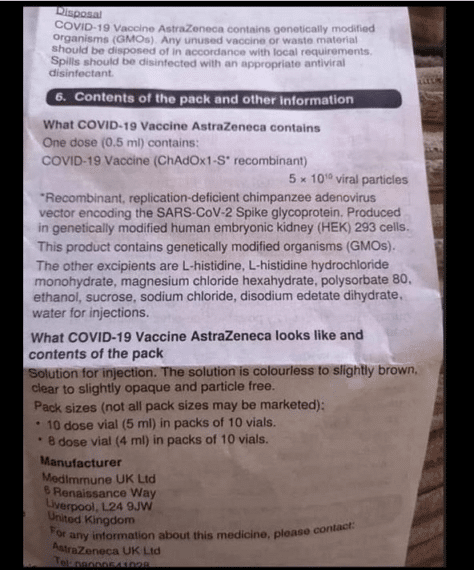It's always good to read the ingredients of products - such as the AstraZeneca vaccination. But it is also more important to understand the information.
The photo of the leaflet for the AstraZeneca vaccination is circulating in social media. A passage in it causes excitement because it says something about genetically modified kidneys from fetuses - does this mean that there are cells from fetuses in the vaccination?
This common photo is:

What is in the package insert
under the section “ Contents of the pack and other information ”, but it is important to read the sentence in its entirety and understand it:
“Produced in genetically modified human embryonic kidney (HEK) 293 cells.”
In German: “ Produced in genetically modified human embryonic kidneys (HEK) 293 cells ”.
This information falls under what is stated in the heading of the “ other information ” section, so it is not part of the AstraZeneca vaccination.
But what exactly are these cells about?
What exactly is HEK-293?
These are actually the kidney cells of a fetus ( see HERE ), which does not mean that the laboratories now constantly need aborted fetuses, because fortunately such cells can be replicated in the laboratory.
The cell line with the number 293 was cultured in 1973 by Frank Graham at the University of Leiden in the Netherlands; they come from an abortion in 1972 ( see HERE, page 77 ).
Why are these cells used in manufacturing?
According to the Vaccine Knowledge Project at the University of Oxford ( see HERE ), some viruses grow much better and more effectively in human cells.
After growth, the viruses are purified several times to remove the cell culture material (including those kidney cells), so it is very unlikely that human cells will remain in the final vaccine.
The production of the AstraZeneca vaccine requires adenoviruses, which transport the genetic material of the coronavirus (specifically a spike of the virus) to the cells in the body. And those adenoviruses are grown in a HEK-293 cell line.
Conclusion
Using clones of kidney cells from a fetus aborted in 1972, viruses are grown that transport the genetic material of the new coronavirus into human cells so that they can replicate the harmless (!) genetic material for a short period of time, whereby our immune system learns to accept SARS-CoV-2 fight if you become infected with it.
However, those human cells do not migrate into the final AstraZeneca vaccination.
[mk_ad]
Additional source: FullFact
Also interesting:
Notes:
1) This content reflects the current state of affairs at the time of publication. The reproduction of individual images, screenshots, embeds or video sequences serves to discuss the topic. 2) Individual contributions were created through the use of machine assistance and were carefully checked by the Mimikama editorial team before publication. ( Reason )

